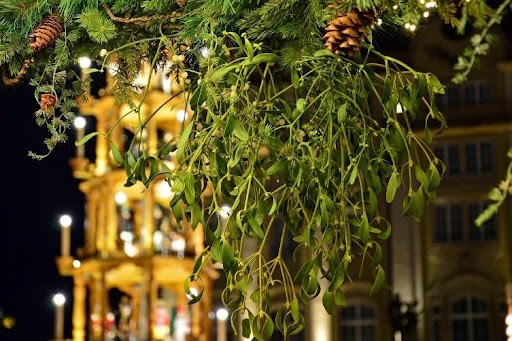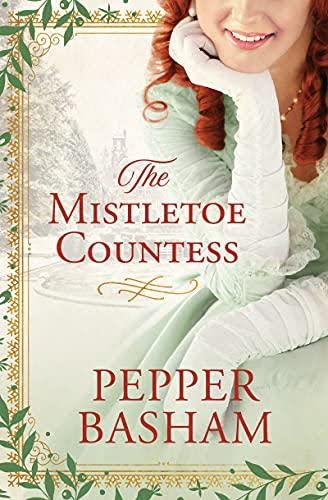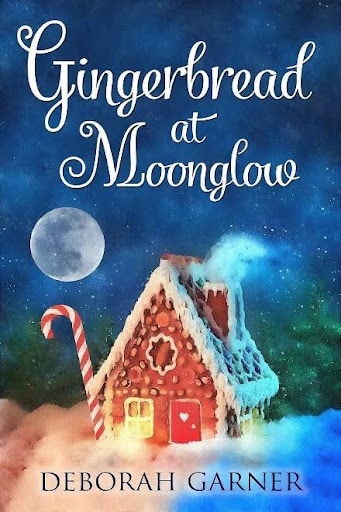When we think of Christmas traditions, often fond memories of decorating a Christmas tree, the hanging mistletoe, or the scent of gingerbread houses come to mind. Follow along as Anita Dickason goes On The Hunt for the origin story behind some of our favorite Christmas memories.

*Affiliate links are used in this article. The Mystery Review Crew is an Amazon Affiliate and, as such, earns from qualifying purchases. See our privacy policy and disclosures for more information.
The Story Behind The Christmas Tree: An Endearing Sight
One of the most endearing sights of Christmas is a tree. Whether prominently displayed in front of windows for passersby to view and admire or tucked into a corner of the living room, small or large, most households have one.

From untangling strings of lights, which mysteriously managed to entwine themselves into an unwieldy clump (I’m sure I didn’t put them in the box that way), to hanging ornaments, decorating a tree, fake or real, is one of the most memorable activities for the holiday season. And when it’s finished, what a heartwarming sight. Twinkling lights and colorful ornaments bring a special kind of magic.
For a child, the tree heralds the coming of Santa Claus (or St. Nicholas if you are outside the United States) and gifts to be found under the low-hanging branches. Of course, those wrapped packages are irresistible to a kid. Can they craftily find out what’s inside and not leave a clue the gift was unwrapped? It can be done. Been there and done that, as the saying goes.
But how did all of this come about? Who started the Christmas tree tradition? It wasn’t the concept of a Christmas tree but rather a tree that never changed color. It always stayed green. Hence the name Evergreen. And why only certain trees were used.
The Winter Solstice is the shortest day in winter. For the ancients, it was a celebration signaling the beginning of a new season. Evergreen trees and their branches were prominently displayed in homes in the hopes of prosperity and good fortune or a religious belief in the continuity of life. During the ancient Winter Solstice in a remote corner of the Roman empire, a banquet decorated with evergreens, the Saturnalia, celebrated the coming spring. Even the ancient Egyptians celebrated the Winter Solstice by decorating their homes with leaves and branches of the Palm tree.
The modern-day use of a decorated Christmas tree has been linked to Prince Albert of Germany. In 1848, Prince Albert gave his wife, Queen Victoria of England, a Christmas tree. The event was memorialized in an illustration on the front page of Illustrated London News—image courtesy of Getty Images: Hulton Royals Collection Hulton Archive.

A Christmas Tree Book Pairing
Falling Stars By Fern Michaels

“Fern Michaels’ Christmas novels are pure holiday magic—uplifting stories of love, family, and friendship in irresistible settings. Here, a ski instructor finds her skills, and her heart, put to the test courtesy of a visiting movie star in this special seasonal tale that will delight Fern fans and those who love Mary Kay Andrews, Debbie Macomber, and RaeAnne Thayne.
Emily Ammerman has always felt at home amid the ski runs and slopes of Snowdrift Summit, the Colorado resort her family has operated for decades. Snow is her element, and she doesn’t hesitate when a new client asks her to train him to ski The Plunge, one of Colorado’s most treacherous runs.
But Zach Ryder is no regular client. On screen, he’s famous for starring as a daring CIA officer who always saves the day. In real life, he’s just as handsome and charming as his alter ego, though not everyone is impressed. Some are concerned about what kind of impact these slick showbiz types will have on their town.
As for Emily—she’s got a secret, and it’s one she can’t reveal to anyone, especially not to Zach: she’s his biggest fan. But she’s also a professional. She’ll train him till he’s ready to tackle any slope, but she won’t fall in love with him, the way so many others have. Still, not everything in life can be planned, and sometimes, no matter how hard you try, you just can’t help but fall . . .ern twist on the Little Mermaid.”
Find it on Goodreads, Amazon, Barnes and Noble, Bookbub, and Bookshop.org
The History Behind Mistletoe
As an avid reader of historical romance mysteries during the Victorian era, the use of mistletoe to create a romantic Christmas scene is a ploy often used. Hung in a doorway, making it impossible to avoid the mistletoe above one’s head, the unwary or maybe the not-so-unwary character, man or woman, would be kissed. A tradition that held if the person refused the kiss, bad luck would follow.

How did this curious tradition of kissing under a plant with white berries come about? It wasn’t until I researched the origins of mistletoe I learned the plant is not nearly as romantic as fictional or historical descriptions have portrayed.
Mistletoe is a parasitic plant that attaches to the branches of trees. It starts from seeds in bird droppings. The origins of the word mistletoe are certainly less than romantic. The name arose from two Anglo-Saxon words, “mistel,” meaning dung, and “tan,” meaning twig or branch. Thus, it became “dung-on-a-twig.”
Not only is the name unromantic, but the plant is also dangerous. The white berries are toxic when ingested by animals or humans. For tree farmers, ornamental, timber or crop trees, mistletoe is a pest causing abnormal growths, known as witches’ brooms. This intriguing descriptive phrase sent my research in another direction. Deformities in branches often resemble a witches’ broom. The branch has a gnarly, twisted appearance with a clump of shrubbery at one end resembling a bird’s nest. Hence the term, witches’ broom.
Since the berry ripens in December and the plant never loses its color, ancient cultures used it as a ceremonial decoration. Some cultures, dating back to the Druids in what is now Scotland and Ireland, believed the plant was a symbol of fertility.
How the custom of kissing under the mistletoe came about is uncertain. However, historians claim it began in the 1500s in England. I was intrigued to discover an author from my article about the origins of the Headless Horseman may have played a role in spreading the custom from England to the U.S. Just as Washington Irving brought legends and traditions from his visit to England about the Headless Horseman in the Legend of Sleepy Hollow, it would seem Irving did the same with mistletoe. In Washington Irving’s short story, Christmas Eve, written in 1820, Irving wrote, “the mistletoe, with its white berries, hung up, to the imminent peril of all the pretty housemaids.”
A Mistletoe Book Pairing
The Mistletoe Countess By Pepper Basham

“Will the magic of Christmas bring these two newlyweds closer together, or will the ghosts of the past lead them into a destructive discovery from which not even a Dickens’s Christmas can save them?
Mistletoe is beautiful and dangerous, much like the woman from Lord Frederick’s Percy’s past, so when he turns over a new leaf and arranges to marry for his estate, instead of his heart, he never expects the wrong bride to be the right choice. Gracelynn Ferguson never expected to take her elder sister’s place as a Christmas bride, but when she’s thrust into the choice, she will trust in her faithful novels and overactive imagination to help her not only win Frederick’s heart but also to solve the murder mystery of Havensbrook Hall before the ghosts from Frederick’s past ruin her fairytale future.”
Find it on Goodreads, Amazon, Barnes and Noble, Bookbub, and Bookshop.org
Christmas Traditions: Gingerbread The Aroma of Festive Cheer
Baking up a batch of gingerbread cookies is a surefire way to spice up a home for the holidays with the mouth-watering fragrance of ginger, cinnamon, cloves, and sweet molasses.

For the intrepid baker, even better is a gingerbread house decorated with candy canes, gumdrops, M&Ms, life savers, and other delectable candies. For a child, decorating a gingerbread may be a close second to decorating a Christmas tree.
Gingerbread has been around for thousands of years. As far back as 2400 BC, Ancient Greeks used gingerbread for ceremonial purposes. Russian bakers added an intriguing twist, turning gingerbread into men and women, supposedly in the likeness of people attending a party. It wasn’t until the 15th century the Germans began making an edible gingerbread structure. However, another version credits the rise of the gingerbread house some 200 years later to the Brothers Grimm tale of Hansel and Gretal, where the children stumble upon a witch’s house made of bread, cake and sugar in the forest. The witch’s cottage soon turned into a holiday tradition of gingerbread houses. Though some argue, the gingerbread house came first, sparking the idea for the book. It’s the type of debate—which came first, the chicken or the egg?
According to the Guinness Book of World Records, the largest gingerbread house was in Bryan, Texas. Built in November 2013 by Texas A&M Traditions Club, the house took nearly a month to build. Approximately 2520 square feet, 60 feet long, 42 feet wide, and 21 feet high, the gingerbread house was nearly the size of a tennis court. The house was constructed using 1,800 pounds of butter, 7,200 eggs, 7,200 pounds of flour, and nearly 3,000 pounds of brown sugar. Add to this the 22,000 pieces of candy that were attached. Visitors to the house met Santa Claus in exchange for donating to St Joseph’s Hospital to raise monies to build a new trauma center.
A Gingerbread Christmas Book Pairing
Gingerbread at Moonglow By Deborah Garner

“The small town of Timberton, Montana, boasts an ambiance of near-magical proportions during the Christmas season, due in no small part to resident artist and chef Mist’s mysterious way of working small miracles in people’s everyday lives. Each year, return guests and new arrivals mingle with local townsfolk to enjoy companionship, exquisite decor, and exceptional cuisine at The Timberton Hotel.
As the aromas of ginger, cinnamon, nutmeg and molasses mix with heartfelt camaraderie and sweet romance, guests share reflections on family, friendship, and life. Although decorating the outside of a gingerbread house may prove easier than deciding what goes inside, no one leaves Timberton without renewed hope for the future.”
Find it on Goodreads, Amazon, Barnes and Noble, Bookbub, and Bookshop.org
We hope you have a Merry Christmas! Let us know what other Christmas Traditions you think we should go on the hunt for next.
Until next time,
Anita

Anita Dickason
Anita Dickason is a retired police officer with a total of twenty-seven years of law enforcement experience, twenty-two with Dallas PD. She served as a patrol officer, undercover narcotics officer, advanced accident investigator, tactical officer, and first female sniper on the Dallas SWAT team.






